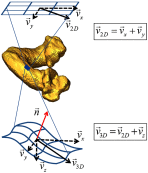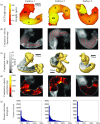Three-dimensional correction of conduction velocity in the embryonic heart using integrated optical mapping and optical coherence tomography
- PMID: 24996663
- PMCID: PMC4082492
- DOI: 10.1117/1.JBO.19.7.076004
Three-dimensional correction of conduction velocity in the embryonic heart using integrated optical mapping and optical coherence tomography
Abstract
Optical mapping (OM) of cardiac electrical activity conventionally collects information from a three-dimensional (3-D) surface as a two-dimensional (2-D) projection map. When applied to measurements of the embryonic heart, this method ignores the substantial and complex curvature of the heart surface, resulting in significant errors when calculating conduction velocity, an important electrophysiological parameter. Optical coherence tomography (OCT) is capable of imaging the 3-D structure of the embryonic heart and accurately characterizing the surface topology. We demonstrate an integrated OCT/OM imaging system capable of simultaneous conduction mapping and 3-D structural imaging. From these multimodal data, we obtained 3-D activation maps and corrected conduction velocity maps of early embryonic quail hearts. 3-D correction eliminates underestimation bias in 2-D conduction velocity measurements, therefore enabling more accurate measurements with less experimental variability. The integrated system will also open the door to correlate the structure and electrophysiology, thereby improving our understanding of heart development.
Figures







Similar articles
-
In vivo gated 4D imaging of the embryonic heart using optical coherence tomography.J Biomed Opt. 2007 May-Jun;12(3):030505. doi: 10.1117/1.2747208. J Biomed Opt. 2007. PMID: 17614708
-
Measuring hemodynamics in the developing heart tube with four-dimensional gated Doppler optical coherence tomography.J Biomed Opt. 2010 Nov-Dec;15(6):066022. doi: 10.1117/1.3509382. J Biomed Opt. 2010. PMID: 21198196 Free PMC article.
-
4D reconstruction of the beating embryonic heart from two orthogonal sets of parallel optical coherence tomography slice-sequences.IEEE Trans Med Imaging. 2013 Mar;32(3):578-88. doi: 10.1109/TMI.2012.2231692. Epub 2012 Dec 4. IEEE Trans Med Imaging. 2013. PMID: 23221816 Free PMC article.
-
Optical Coherence Tomography for live imaging of mammalian development.Curr Opin Genet Dev. 2011 Oct;21(5):579-84. doi: 10.1016/j.gde.2011.09.004. Epub 2011 Sep 29. Curr Opin Genet Dev. 2011. PMID: 21962442 Free PMC article. Review.
-
The application of optical coherence tomography angiography in retinal diseases.Surv Ophthalmol. 2017 Nov-Dec;62(6):838-866. doi: 10.1016/j.survophthal.2017.05.006. Epub 2017 Jun 1. Surv Ophthalmol. 2017. PMID: 28579550 Review.
Cited by
-
Using optical coherence tomography to rapidly phenotype and quantify congenital heart defects associated with prenatal alcohol exposure.Dev Dyn. 2015 Apr;244(4):607-18. doi: 10.1002/dvdy.24246. Epub 2015 Mar 13. Dev Dyn. 2015. PMID: 25546089 Free PMC article.
-
Optical coherence tomography for embryonic imaging: a review.J Biomed Opt. 2016 May 1;21(5):50902. doi: 10.1117/1.JBO.21.5.050902. J Biomed Opt. 2016. PMID: 27228503 Free PMC article. Review.
-
Mapping conduction velocity of early embryonic hearts with a robust fitting algorithm.Biomed Opt Express. 2015 May 18;6(6):2138-57. doi: 10.1364/BOE.6.002138. eCollection 2015 Jun 1. Biomed Opt Express. 2015. PMID: 26114034 Free PMC article.
-
Supplementation with the Methyl Donor Betaine Prevents Congenital Defects Induced by Prenatal Alcohol Exposure.Alcohol Clin Exp Res. 2017 Nov;41(11):1917-1927. doi: 10.1111/acer.13495. Epub 2017 Oct 11. Alcohol Clin Exp Res. 2017. PMID: 28888041 Free PMC article.
-
Optical Electrophysiology in the Developing Heart.J Cardiovasc Dev Dis. 2018 May 11;5(2):28. doi: 10.3390/jcdd5020028. J Cardiovasc Dev Dis. 2018. PMID: 29751595 Free PMC article. Review.
References
Publication types
MeSH terms
Grants and funding
LinkOut - more resources
Full Text Sources
Other Literature Sources

